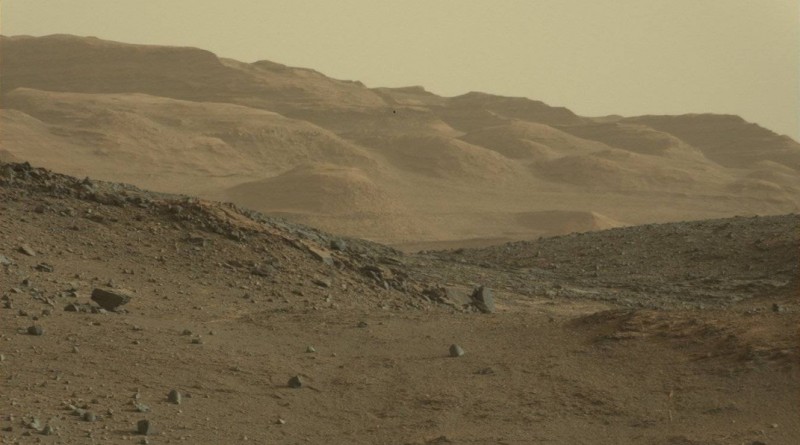Curiosity celebrates 1 000 Sols on Mars – MSL to hunker down for Conjunction
Originally published on May 30, 2015
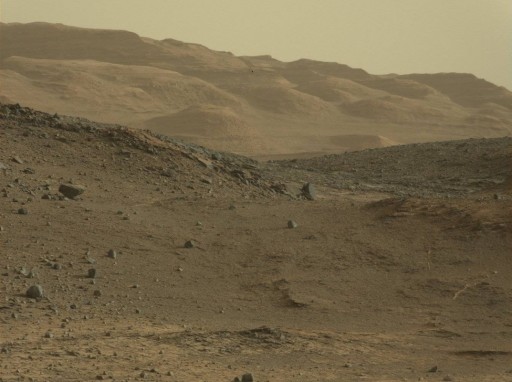
NASA’s MSL Curiosity rover passed the 1,000-Sol mark on Saturday, having been roving the Martian surface for 1,000 Mars days since its landing in August 2012. The rover remains in very good condition in the midst of its extended science mission that aims to explore the different layers of Aeolis Mons, the large mountain in the middle of Gale Crater, to obtain a detailed record of a changing Martian environment over the planet’s evolution from a warm and wet world that may have harbored life to the deserted and cold place Curiosity can observe today.
Over the first 1,000 sols of the mission, Curiosity has been performing very well – only suffering minor interruptions associated with smaller kinks in some of its systems that could be swiftly overcome by the rover’s operators. With a well functioning rover, the Curiosity mission could focus on science operations that started out on the floor of Gale Crater where MSL touched down and initially headed east to the Glenelg area where Curiosity spent several months, discovering an ancient Martian environment with flowing water suitable for forms of life.
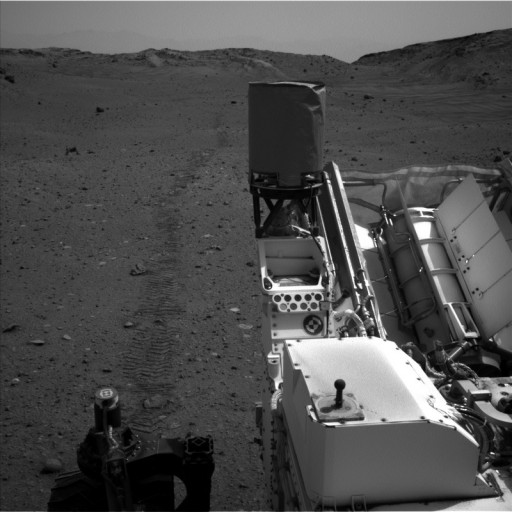
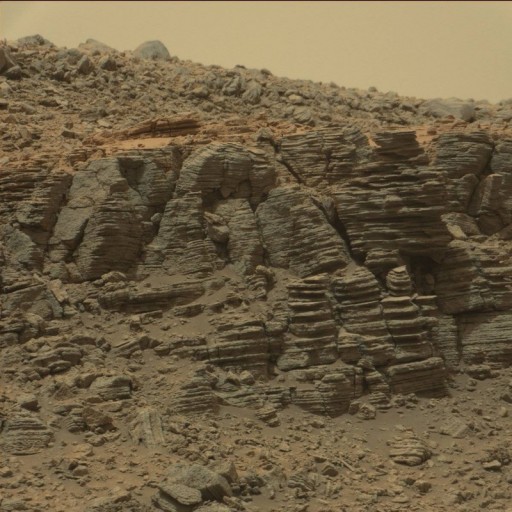
Wrapping up at Glenelg, Curiosity started a very long journey to the south west, heading towards the lower reaches of Aeolis Mons, the primary science target of the mission. Along the way, MSL made a number of stops for occasional rock drilling and other science campaigns before finally reaching the lowest layer of the mountain in mid 2014.
Over its first 1,000 Sols, Curiosity also supported the search for methane and organics on the surface of Mars, obtained a detailed record of the radiation environment and continuously monitored the weather inside Gale Crater with its REMS instrument suite.
Having already completed its primary mission objective of determining whether ancient Mars provided an environment suitable for life, Curiosity entered its extended science mission after two years of operations with work beginning to explore Mount Sharp. The campaign of exploring the layers of the mountain started in the lower reaches of Aeolis Mons to study the materials deposited in a more distant past than those layers situated atop.
The past 50 sols were mostly dedicated to driving operations as Curiosity headed from Pahrump Hills where it spent six months to its next science destination known as Logan Pass. There, scientists hope to find information that exposes the relationship between the Murray Formation at the base of the mountain and the Washboard Unit a little higher up to understand the conditions in which the two different formations were formed.
Sol 950 to 1,000 Summary
Wrapping up operations at Garden City, Curiosity was set on Sol 950 to begin the trip up the lower reaches of Mount Sharp to make a slow ascent to gain access to interesting surface features that are awaiting detailed study.
The rover team had chosen the scenic route for Curiosity, taking the rover though a valley named Artist’s Drive starting with a drive of over 30 meters on Sol 950 with plenty of imaging along the way and after the traverse was complete to document the features of the valley walls with particular interest in the stratigraphy of the walls to the northeast and southwest.
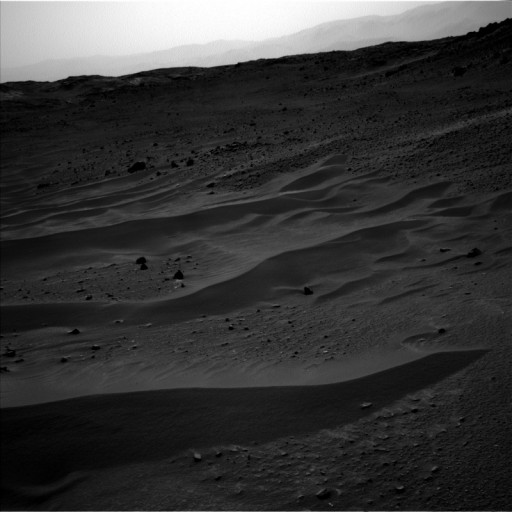
The next sol started with a short science block filled with MastCam imaging and targeted ChemCam observations followed by a short drive to a good observation location, bringing Curiosity’s odometer to over 10 Kilometers of driving distance on Mars, or rather wheel odometry since wheel slippage is counted by the odometer so the total driving distance was not quite at 10km.
The 18-meter drive on Sol 951 was followed up with a longer drive of nearly 100 meters the next Sol given the favorable planning position that allowed rover drivers to oversee a large area that was easy to traverse. The drive was followed up with a 360-degree panorama in addition to the standard post-drive imaging operations.
On Sol 953, MSL took some time to conduct a lengthy test of the ChemCam focus function at different times of day to study the influence of temperature on the instrument function. The focus of the next sol was a large MastCam mosaic of target Mount Saint Mary followed by the transfer of some of the remaining sample from the Telegraph Peak drilling campaign to the SAM instrument. The rest of the sample was dumped to allow the Alpha-Particle X-Ray Spectrometer to complete an overnight integration.
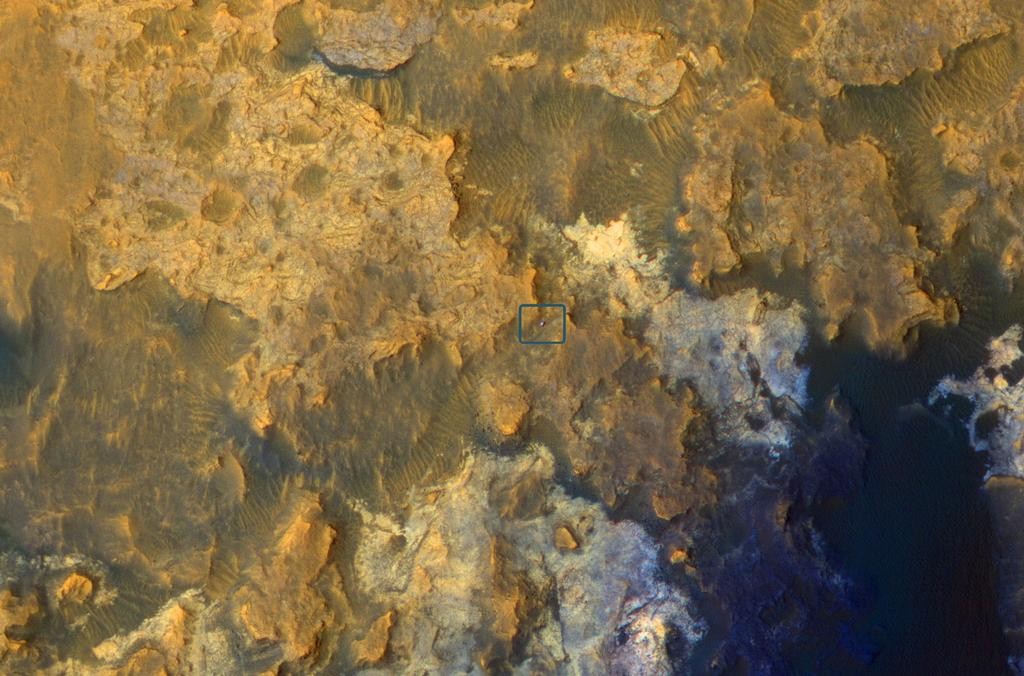
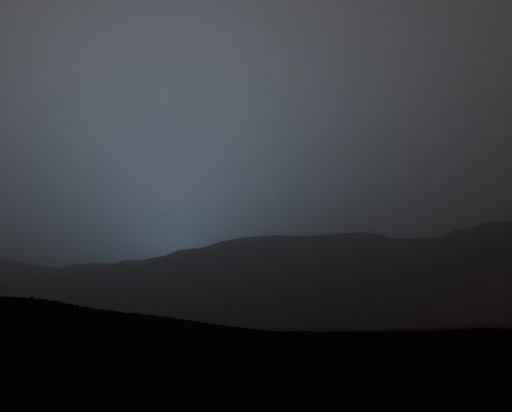
Sol 955 started with ChemCam observations and MastCam imaging of the dumped drill sample plus a small mosaic of the expected driving direction. Shortly after sunrise on Sol 956, MSL used its NavCam to make a movie for atmospheric studies while MastCam was used for dust measurements at the low sun angle. Next was a long drive of 65 meters and in the evening, Curiosity used its cameras to observe the sunset, attempting to spot Mercury as it transits the face of the sun. It was the final Mercury transit for the Gale Crater location until 2024, but images acquired by the MastCam did not show Mercury.
Sol 957 was another very standard sol – targeted science, drive, post-drive imaging for targeted science ops in the morning.
The drive successfully brought MSL’s true driving distance to 10 Kilometers, but placed the rover in front of a ridge, making future drive planning difficult. Curiosity made up for that on Sol 958 with a short drive to reach a good position to image the terrain in front of the rover for future drives. The plan also included ChemCam observations and MastCam mosaic imaging.

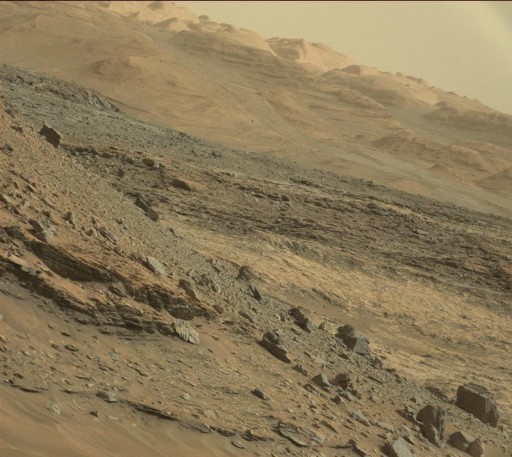
For Sol 959, Curiosity took a day off from driving for extensive imaging operations of an outcrop called “Daughter of the Sun” with several MastCam mosaics and ChemCam examinations of multiple targets. A long 102-meter drive was on tap on Sol 960 with associated DAN observations to measure the Hydrogen content in the subsurface. The next Sol was filled with ChemCam calibrations and atmospheric observations by the cameras. With plenty of driving performed by Curiosity, the time came on Sol 962 for a detailed MAHLI imaging session of the wheels to check for any new damage.
Driving towards “Logan Pass” resumed on Sol 963 after a study of a variably-toned rock in front of the rover. The planned 48-meter drive was stopped after 17 meters when Curiosity’s AutoNav system encountered a large rock which then became the impromptu science target of Sol 964 before the next drive to get over to Logan Pass. Initially, Curiosity aimed for a spot west of Logan Pass because scientists found an interesting outcrop that warranted further study.
Entering restricted planning Sols, Curiosity had a light day on Sol 966 with some ChemCam and MastCam observations of two targets plus atmospheric monitoring with a 90-meter drive on Sol 967 and a calibration day for CheMin and ChemCam on Sol 968.
Arriving close to the Mt. Shields outcrop (see map below), MSL completed mosaic imaging with MastCam and spectroscopy with ChemCam on Sol 969 and Remote-Micro Imager focus-stack imaging the next sol ahead of nighttime images of Mars Moon Phobos as it entered eclipse.
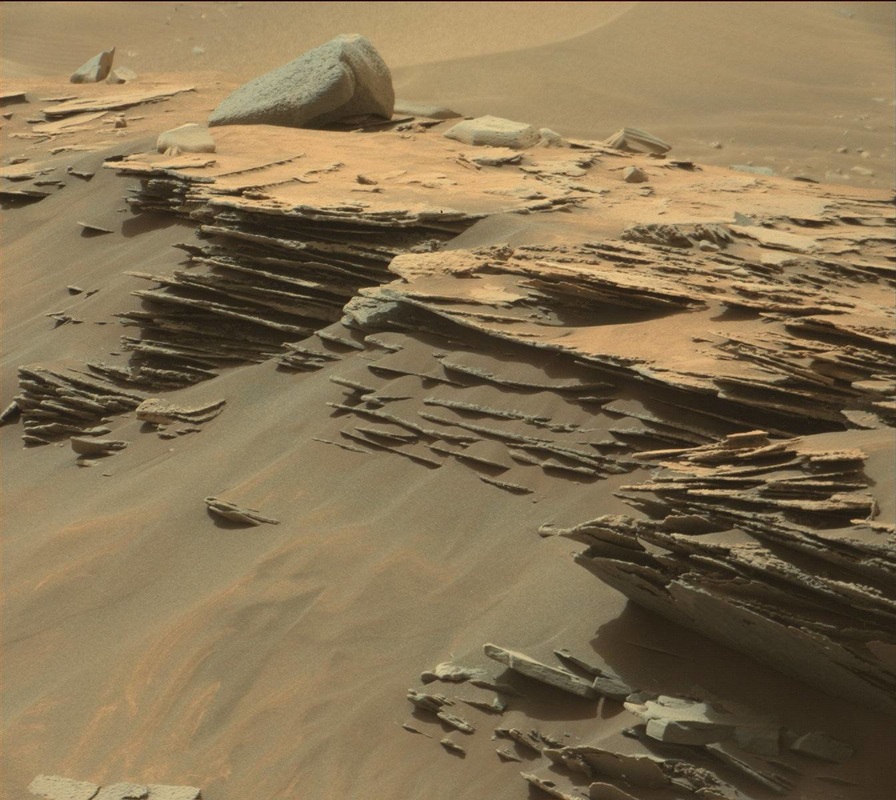
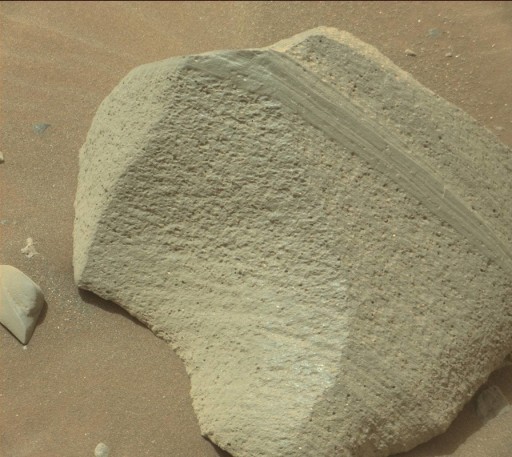
Sol 971 started with ChemCam and MastCam operations to examine a nearby rock and RMI imaging of more distant targets before Curiosity headed off towards an outcrop selected for contact science. CheMin was in action overnight, completing a measurement on an emptied sample cell to confirm no residual material remained inside. The next Sol was filled with calibration activities for ChemCam and cloud imaging by NavCam as well as a SAM maintenance operation overnight.
Heading into a 3-sol weekend plan, MSL got to work on science operations with ChemCam and MastCam observations of near targets, RMI imaging of a distant outcrop and CheMin dumping sample from another cell overnight. Arm operations started on Sol 974 with MAHLI mosaic imaging on a target called Bigfork that was then analyzed by APXS. Sol 975 started bright and early with dust observations in the atmosphere before the Dust Removal Tool was employed to clean the Albert Rock for MAHLI imaging and an overnight APXS integration (see photos below).
After final imaging at the outcrop, Curiosity hit the road again on Sol 976 with a 60-meter drive to the west towards Jocko Butte. SAM analyzed atmospheric gas overnight to determine the concentration of noble gases.
Atmospheric observations and a small MastCam mosaic were on tap for Sol 977 with even more imaging the next Sol on five targets as well as active laser-induced breakdown spectroscopy ahead of a drive towards Logan Pass that was stopped prematurely when MSL detected excessive wheel slippage.
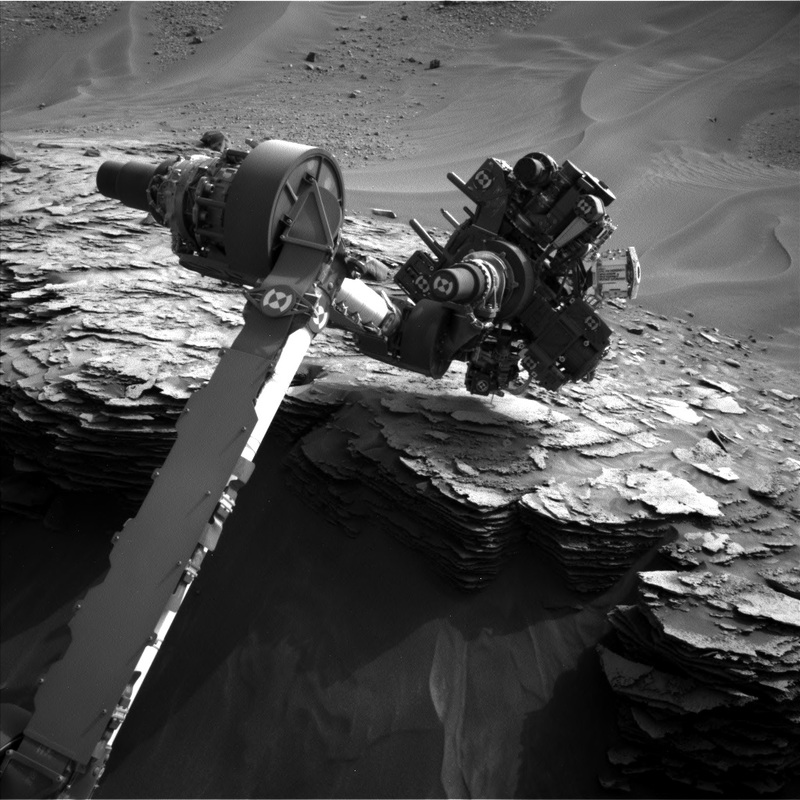
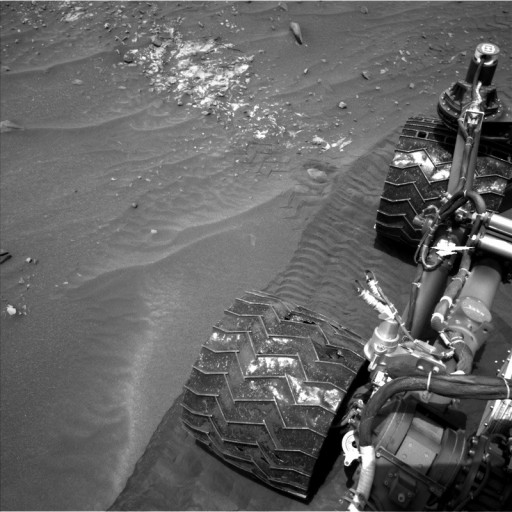
ChemCam calibrations were performed on Sol 979 with another series of nighttime MastCam imaging activities to capture shots of Phobos when still illuminated by the sun and when in eclipse to allow a comparison between them to assess the amount of dust suspended in the atmosphere.
Two targets were imaged by MastCam on Sol 980 before crater rim and sun imaging the next Sol followed by a drive with the normal post-drive photo acquisition and a mosaic of Logan Pass. ChemCam received a software upgrade on Sol 981 restoring its Autofocus Feature that had to be tweaked after the focusing laser of the instrument showed some degradation. Back to its old capabilities, ChemCam will use its LIBS laser for initial focusing before completing the particular science sequence. No activities except for REMS maintenance were completed on Sol 982 with the next Sol featuring a drive around sandy ripples, still en-route to the outcrop west of Logan Pass.
Despite an effort to route the rover around the sand, MSL’s software detected slippage and stopped the drive sequence, requiring teams to adjust the traverse path to allow the rover to drive onto a low ridge, but this drive was also stopped due to slipping wheels. Curiosity came to a stop at a tilt angle of 21 degrees, a record for the mission so far. To allow drivers to re-plan a safe route, Curiosity remained in place on Sol 985, checking out the new Autofocus feature of ChemCam and acquiring imagery with MastCam.
Mosaic photo acquisition was the plan for Sol 986 to help find a good drive path towards the Mt. Stimson outcrop. Also, ChemCam completed more Autofocus testing and Curiosity made a short drive backwards to reduce its tilt angle and head back to Jocko Butte in a 43 meter drive on Sol 987.
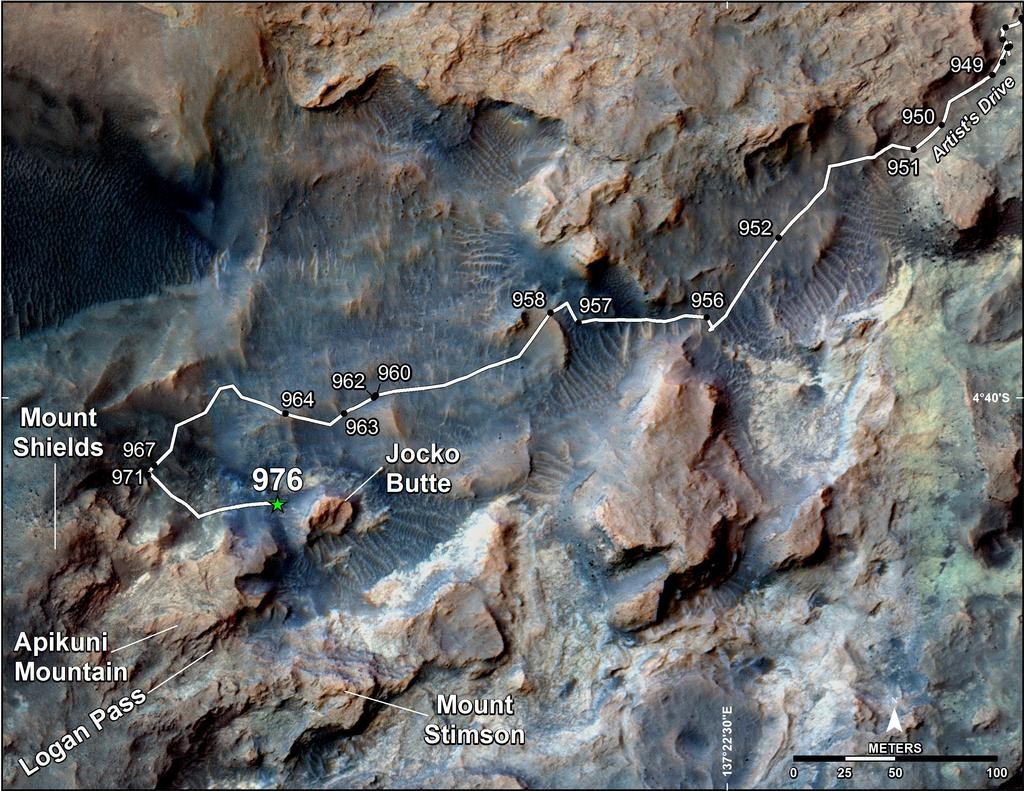
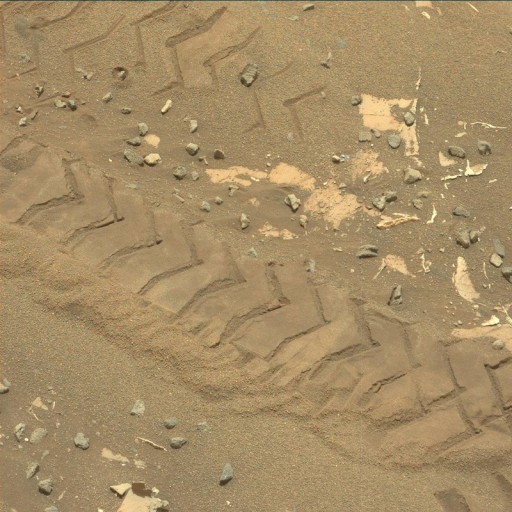
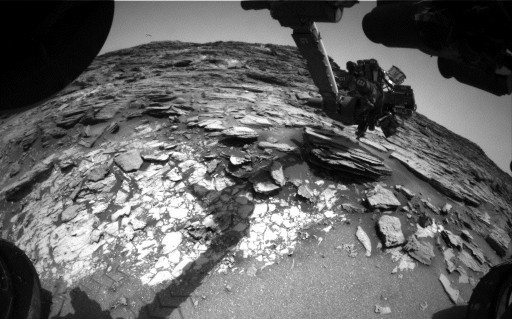
The plan for 988 included untargeted observations of surface features and the atmosphere. APXS, ChemCam and MastCam were in action the next Sol and so was the robotic arm to try out a number of settling tests with MAHLI to assess the interval needed between arm motion and imaging to ssess the dampening of vibrations for clear image acquisition. A drive to the west was completed on Sol 990 after MastCam and ChemCam observations of nearby targets and NavCam activities to search for dust devils. Going along a re-planned route, Curiosity drove 22 meters through Marias Pass on Sol 991 to reach the initial target seen near Logan Pass.
Driving paused on Sol 992 for Curiosity to acquire ChemCam and MastCam observations of two targets and to provide characterization of the bedrock on a nearby boulder. MastCam mosaics were acquired to assess the local stratigraphy and put the local geology into a context with respect to the areas observed earlier in the mission. A short drive of six meters put Curiosity in position for targeted science over the long Memorial Day weekend.
The plan was filled with plenty of MastCam mosaic imaging as well as operation of the ChemCam instrument on four targets. A short bump on Sol 995 placed the rover closer to the target outcrop to set up for contact science. Nighttime MastCam imaging of the star-filled sky and Mars moon Deimos was performed and Sol 996 was a quiet day, only including the standard REMS monitoring. Two raster observations with ChemCam were conducted the next sol with more MastCam mosaics to characterize sediments encountered by Curiosity followed by another short 2.5-meter bump to finalize the positioning for contact science ops.
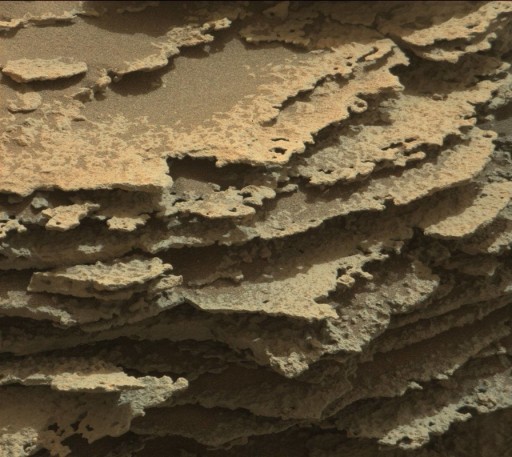
The Sol 997 bump was the final drive for several weeks as Solar Conjunction approaches – a period of time when the sun is right between Earth and Mars preventing communications with the spacecraft at Mars. Parked in a good position in front of the Stimson outcrop, Curiosity is set for plenty of work ahead and after conjunction, starting on Sol 998 with MastCam image acquisition before the arm was deployed for MAHLI imaging of a coarse-grained rock section and the Ronan target that was later brushed off for APXS observations.
The next sol looked very similar with detailed observations of a unit referred to as Pahrump. MAHLI was particularly busy on Sol 999 as this was the last Sol before conjunction since teams need to confirm the Dust Cover is closed on MAHLI before the operational stand-down.
The next sol looked very similar with detailed observations of a unit referred to as Pahrump. MAHLI was particularly busy on Sol 999 as this was the last Sol before conjunction since teams need to confirm the Dust Cover is closed on MAHLI before the operational stand-down.
Solar Conjunction represents a period when Earth and Mars are at opposite positions in their orbits with the sun in between. This constellation occurs every 26 months, but each conjunction is different depending on the specific orbital geometry and solar activity. Radio commands can be impaired or altered when interacting with the plasma in the sun’s atmosphere – this is why communications from Earth to Mars are ceased around the time of conjunction and signals from Mars to Earth are reduced to a minimum.
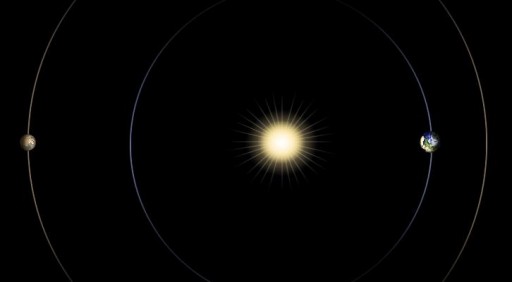
Curiosity will continue to send its daily “status beep” via X-Band which tells teams that the rover is operating nominally.
Throughout the conjunction period, MSL will continue its basic science tasks such as taking images with the NavCams for environmental studies. Also, Curiosity will operate its REMS Weather Station and Radiation Assessment Detector. Data will be stored aboard the rover and sent via the standard UHF passes to the Mars Reconnaissance Orbiter which will receive and store the data.
The conjunction gives scientists and engineers time to catch up with open tasks or to look at data acquired recently without having the daily task of planning rover operations on a Sol-by-Sol basis.


